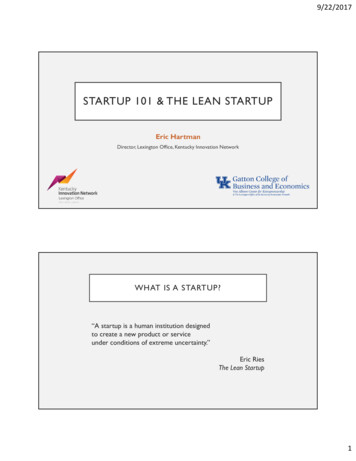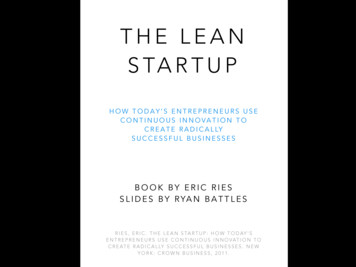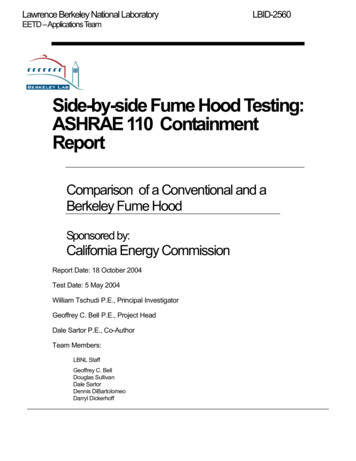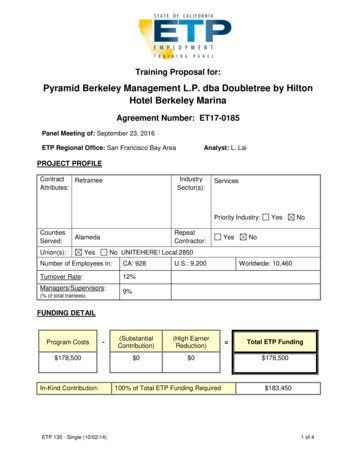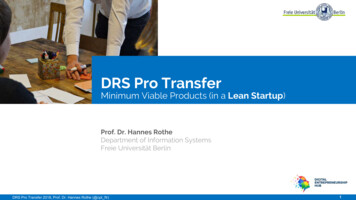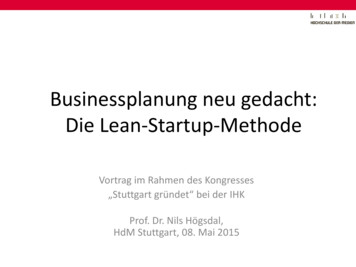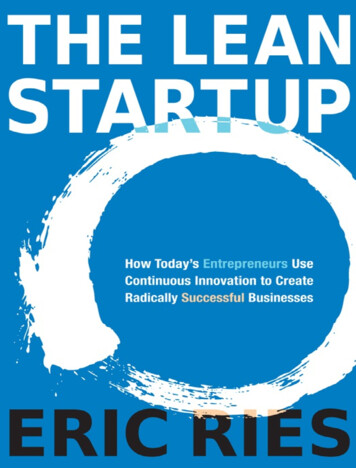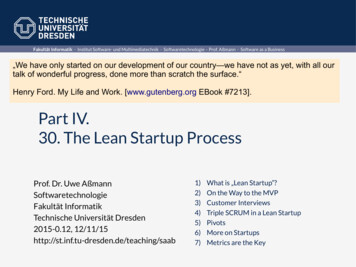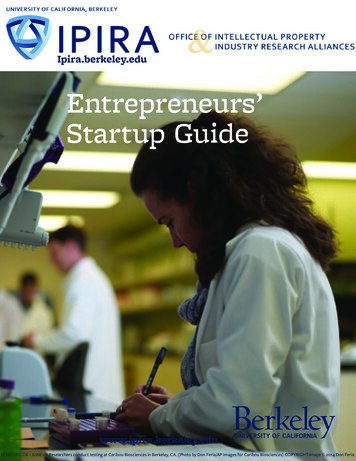
Transcription
Ipira.berkeley.eduEntrepreneurs’Startup Guidewww.ipira.berkeley.edu1BERKELEY, CA - JUNE 16: Researchers conduct testing at Caribou Biosciences in Berkeley, CA. (Photo by Don Feria/AP Images for Caribou Biosciences) COPYRIGHT:Image 2014 Don Feria
Table of ContentsIntroduction3Licensing from the University4The Mission of University Technology Transfer4The Licensing Process6Managing Conflict of Interest7Forming the CompanyFrequently Asked Questionswww.ipira.berkeley.edu8192
IntroductionUniversities, with their significant investment in research, discovery, and problem solving, are a fertileground for innovations that can potentially be used to create novel products and services that will benefitthe public. A significant investment of both time and resources is required to translate an academicdiscovery into the marketplace as new technology and products and success is not guaranteed. Toencourage development, university technology transfer offices secure intellectual property rights thatcan protect the investment required to bring a new technology to market. Successful technology transferallows research programs at universities to achieve greater impact and concretely improve the lives of ourcitizens, while also generating revenue, which can support future research programs and provide a return orstakeholders such as inventors, research programs, and the taxpayers who initially supported the research.This document is intended for university researchers, as well as students and others who might partner withthe University to create start-up companies based on novel university technologies.This guide is intended to help University researchers, including faculty and students, understand theprocess involved in starting a company around a university innovation. Many innovations made at researchuniversities fail to achieve the full flower of their potential because they require resources that lie outsideof the university in order to do so. Starting up a company is one way for innovations to “graduate” from theUniversity and take on a life of their own - while creating benefits to everyone who helped make that happenalong the way.This guide will also identify resources available on your campus, in your local community and around thestate of California that can help you develop a plan to go from where you are to where you want to be, andto address and understand topics like conflict of interest and how to manage it, utilization of universityresources, external resources for startups; university intellectual property rights and policies, and more.Ekso Bionics, a Berkeley Startup, helps survivors of lower extremity weakness to walk again.www.ipira.berkeley.edu3
Licensing from the UniversityThe Mission of University Technology TransferOne significant aspect of the UC’s public service mission is to ensure that the results of its research aremade available for public use and benefit. For over 45 years, UC’ has maintained an active and productivetechnology transfer program to encourage the development of commercial products and services based onUC’s academic discoveries. A few examples of products that have been commercialized from UC researchinclude drugs to treat cancer, malaria therapies, search engines, surgical devices, clean water treatments andenergy-efficient light bulbs.Given that University results are often basic research results from academic studies, they are far from beinga commercial product. The road to commercialization is truly a long and winding one. Typically, a series ofsteps are required to bring a research discovery to the point of practical application and many players play arole in the process. This process is often referred to as one form of technology transfer from universities.In this schematic, some of the categories of steps are shown. In a generalized depiction, basic researchresults are translated into applied research and development with the aim of creating commercial goodsand services. The timeline to successfully develop a commercial product from an academic discoverycan vary widely but is most often between 3-10 years. Importantly, in the case of drug development, thecommercializationprocess can take well over 10 years and6/25/15can cost several billion dollars.UC Berkeley Innovation CommercializationUC is a nonprofit research university, not a company. The UC does not directly commercialize our ownresearch discoveries (we don’t manufacture products to a commercial standard and are nonprofitinstitutions). In order to assure our research is developed into beneficial products and service, the UCsecures intellectual property rights, when appropriate, and then license those rights to companies in theprivate sector who develop the commercially available products and services.IP Licensing: Commitment f (Risk)PartnerCommitmentCommitmentincrementally increasesas risk decreases Issue Fee (& equity) Earned Royalties Min Annual Royalties Indemnification below Annual Fee Diligence Terms below Comm Plan Patent Costs below Steps(simplified)Page 30www.ipira.berkeley.edu4
In this context, a license is a contract from UC that grants to an industry licensee (i.e., the start up company)the right to commercialize a patented invention or copyrighted work to make a product or offer a service. Apatent is a form of intellectual property protection that grants to the owner (a licensee) the right to excludeothers from making, using, selling and importing products based on a patented invention. The U.S. patentsystem provides a limited period of time, 20 years, to the patent owner to protect the invention. A copyrightprovides a similar ability to exclude, and is the primary form of intellectual property protection for computersoftware, educational curriculum, books, music and other art forms. The term of copyright is much longer—if owned by a corporation or university, 95 years from first publication or 120 years from creation, whicheverexpires first.Companies with a license to university intellectual property (typically referred to as a “licensee”) investenormous sums in risky R&D; manufacturing and regulatory approvals to bring early stage discoveries to thepoint of practical application. Without the protection afforded by the patent license industry would not riskfunds & resources on lengthy R&D programs that are necessary to commercialize products and the benefitsof university research risk remaining unused in the “ivory tower.”If, at the end of a long and arduous R&D process a licensee AND its competitors could reap the benefits ofthe R&D investment, then no company would make the investment to begin with. The bottom line is that IPlicensing gives industry an incentive to invest.Inventors and entrepreneurs who wish to license IP rights from the University to form a new entity, a startupcompany, are often best suited to commercialize the IP rights—after all, entrepreneurs have the expertise,know-how and the passion, drive and singular focus that is necessary to commercialize the rights. The UCdefines a startup company as a company that was founded to commercialize UC IP rights under license. InFY2013 UC formed approximately 71 startups from university research. In FY2013 U.S. universities produceda total of 818 startup companies from university research. Nearly all IP licenses to startup companiesare exclusive to provide an incentive to invest in high-risk research and development and to rewardentrepreneurs for their commitment to the commercialization process.Innovation is a virtuous cycle of creation, translation, value creation, and reinvestment in researchwww.ipira.berkeley.edu5
The Licensing ProcessBecause the University must locate research funding from a variety of diverse organizations, often, theuniversity will owe obligations to the research funder that must be included in a license agreement. Themost common source of research funding is the federal government. The U.S. Bayh-Dole Act, which grantsuniversities title to the patentable inventions they create under a federal grant or contract, requires theuniversity to manage federally funded intellectual property in accordance with certain rules. For example,Bayh-Dole requires universities to grant a non-exclusive license to the U.S. federal government for its ownuse, distribute a portion of net revenues to inventors and, when the university issues an exclusive licenseto a federally-funded invention, it is required to assure the license contains commercial diligence terms,“preference for US industry” conditions, and march-in rights of the U.S. government. If a licensing term isa condition of the funding used to create the intellectual property, the university is legally bound to includethat term in its licenses.There are several different forms of licensing arrangements that can be explored by a start-up company:Letter AgreementA letter agreement is a simple, one to two page agreements, in a letter format with minimal “legalese,”where the university promises to negotiate the terms of a license for a short period of time (3-12 months,depending on campus practices). In exchange, the company typically reimburses the cost of certain patentcost incurred by the university for the licensed invention and will pay a one-time, relatively modest fee. Aletter agreement can be an effective tool to secure access to a patent or copyright while the company isbeing formed, seeking initial funding and conducting a detailed analysis of the business opportunity.Option AgreementAn option agreement is a legal contract that allows the start up company to exercise a right to obtain alicense at any time during a fixed time period. The term of an option is typically 1—3 years, dependingon circumstances. The standard terms for an option agreement are an annual fee (with the first fee dueupon signing the agreement) and reimbursement of certain patent costs incurred by the University for theLicensed Invention. An option agreement is a good mechanism to employ if the start-up company is readyto commit to development of the technology, but the precise business model, profit margins and otherfinancial details are not yet predictable. It is also a good mechanism if the start up company does not knowhow the optioned technology will ultimately fit within its product line. Because the option agreement is anoption to secure a license, but not itself a license, the optionee is not granted the right to sell products orservices.License AgreementA license agreement grants the start up company all of the rights necessary to sell commercial products.It typically lasts for the life of the patent (although it can be terminated by the company at any time, uponnotice). The terms of a license agreement vary widely, as each agreement is customized to reflect thespecifically anticipated products and market, the development stage of the company and the technologybeing licensed, and the role the licensed intellectual property. The UC follows industry norms whendeveloping financial and business terms and has “comparables” from thousands of licenses within the UCsystem and across the U.S. and Canada. There are several standard terms for license agreements that areimportant to understand: Earned Royalties. Earned royalty rates are negotiated as part of the license agreement. Rates dependon a variety of factors such as the value of the invention, the cost of commercializing the invention,profit margins, and whether the license is exclusive or nonexclusive.www.ipira.berkeley.edu6
Annual Maintenance Fees/Annual Minimum Royalties. Once the licensee introduces commercialproducts, the annual fees become a minimum annual royalty and are creditable against earned royalties owed by the licensee to the UC. For example, if a licensee owes a minimum annual royalty of 5,000, but sells products that generate 10,000 in earned royalties to UC, it pays only 10,000 to theUC, as the earned royalty exceeded the minimum annual royalty. Patent Cost Reimbursement. The licensee is required to reimburse the UC for the costs of securingthe licensed patent rights. Sublicensing Revenue. If the licensee authorizes others to use the licensed patents, the UC requiresthat the sublicensee pay royalties at the same rate as the licensee on the products sold by the sublicensee and if the licensee receives any fees or other payments in exchange for the sublicense of UC’spatents, the UC must receive a share of that revenue. Due Diligence. The UC licenses IP rights to commercial companies that can diligently develop productsand services for the public benefit. To assure a start-up is actively developing products and services,key development milestones are placed in the license agreement with a deadline for meeting them. Equity. Startup companies face the combination of high developmental costs and risk, uncertainty as tothe potential value of the technology and are “cash-poor but equity-rich”. Small and startup companies may find it particularly difficult to commit significant cash outlays for both R&D and licensingcosts. Accordingly, the University may accept equity in a company as partial consideration for technology licensing-related transactions. The decision whether to offer equity is the company’s to make—theUC does not require equity in exchange for a license. To learn more about UC’s policy on equity, pleasesee: http://www.ucop.edu/ott/genresources/equi-pol.html Milestone Payments. At times, when flexibility is needed, UC is able to agree that certain fixed feeswill be paid upon the achievement of specific milestones, such as first commercial sale or initiation ofthe first Phase I clinical trial. These milestone payments, which occur later in time, can sometimes beused to reduce some of the licensee fees for the first years of the company’s life.MANAGING CONFLICT OF INTERESTIPIRA works with Berkeley inventors to facilitate technology transfer and to manage the licensing process.In the case of a Berkeley start-up, the process can raise Conflicts of Interest. A full explanation of Berkeley’spolicies and procedures regarding Conflict of Interest are available at http://spo.berkeley.edu/policy.html#ucBecause inventors may have the opportunity to influence University licensing decisions in ways that couldlead to personal gain or give advantage to companies in which they have a financial interest, inventors mustcomply with the disqualification and disclosure requirements of the Act.The disqualification requirements of the Act require an inventor who has a disqualifying personal financialinterest in a University licensing decision to refrain from influencing the decision. However, if the LicensingProfessional determines that the inventor’s involvement is necessary, or if the inventor will negotiate“across the table” from the University on behalf of a company in which the inventor has a disqualifyingpersonal financial interest, the inventor may participate so long as proposed University licensing decisionsare reviewed by a Licensing Decision Review (LDR). (Note: Under the Act, University negotiations withan inventor who is also the sole proprietor or who solely, or jointly, with his or her spouse, exercises soledirection and control of a candidate licensee may not trigger LDR.The disclosure requirements of the Act require the inventor to specifically disclose any disqualifyingpersonal financial interest in the licensing decision when he/she is involved in a proposed University licensingdecision.www.ipira.berkeley.edu7
SkyDeck provides Berkeley startups access to resources to cultivate their vision and grow their business.Forming the CompanyLaunching a successful start-up company based on university technology requires commitment, hardwork, good timing and, at times, luck. Every successful start-up has its own unique story, but somequalities are consistently seen in success stories: a compelling solution to a market need, a substantialmarket opportunity, sound competitive advantage(s), solid business and financial planning, and a strongmanagement team.There is no standard timeline for launching or growing a start-up. Launch and growth both depend onmultiple factors, such as the maturity of the technology, the acquisition of funding and other necessaryresources, the market, and business trends.The company founders will spearhead company formation and will be the key champions for the start-upduring its launch. In the beginning, the founders will need to complete several tasks in parallel: (a) licenserights to the technology; (b) identify and research key commercial advantages; (c) develop a business plan;(d) pursue financing; and, (e) build the management team and advisors.University researchers should carefully consider their potential role in the new start-up company. Directinvolvement in the company can be rewarding and offers a front row seat to the commercialization of thetechnology that the research group worked so hard to create. However, launching and sustaining an earlystage technology company takes considerable time and effort. Researchers who do not have the abilityto commit significant time and effort or who want to focus on academic research may want to considerparticipating through advisory or consultant roles, with the company’s core business team performing theheavy lifting.While every start-up is different, there are common steps to launching a start-up company:Entrepreneurs should seek input and advice from as many experienced business people and potentialcustomers as possible and listen carefully to the rationale behind conflicting viewpoints on similar issues.In an area as complex as launching a new technology company, no single advisor or mentor will have all theright answers or expertise. Further, as the company progresses, mentors and advisors often have valuableconnections to funding and potential customers. Seek out networking events, trade conferences andpersonal recommendations to build a strong, diverse network of mentors and advisors.www.ipira.berkeley.edu8
UC Berkeley’s Entrepreneurship EcosystemRESEARCH & EDUCATION STUDENT GROUPS COMPETITIONS & EVENTSINCUBATORS & ACCELERATORS INVESTORS & ADVISORSBerkeley’s entrepreneurial ecosystem provides a wealth of support for startups in diverse areas.Agora Startup House is a residential incubator for Cal Students that offers access to a lineup of guestmentors.Association of Chinese Entrepreneurs was founded in 2012, ACE promotes student interest in technology,innovation and entrepreneurship in China. ACE hosts events and learning opportunities, and collaborates with both US universities and Silicon Valley firms.Berkeley Entrepreneurs Association helps equip members for business plans, elevator pitches, slidedecks and Q&A. They are responsible for hosting Pitch Labs, and providing a number of additionalresources.Berkeley Entrepreneurs Forum brings together students and the Bay Area community to meet with andlearn from seasoned entrepreneurs.Berkeley Innovation brings together undergraduates who share a love of design, thinking and innovationwww.ipira.berkeley.edu9
Berkeley Postdoc Entrepreneurs Program provides the postdoc and graduate community with tools,mentoring, and a platform for science/industry interaction to enable research innovations to moveinto the marketplace.Berkeley Startup Cluster hosts events, facilitates networking, and brings together community resourcesfor entrepreneurs and companies in the Berkeley area. The BSC is led by representatives of the Cityof Berkeley, the Downtown Berkeley Association, the Berkeley Chamber of Commerce, and UC BerkeleyCenter for STEM Innovation, Leadership, and Diversity is a group of highly motivated and talentedundergraduates, many fist in their families to attend college, who engage in research, participate inprofessional development workshops, work collaboratively in academic study groups, and prepare forsuccessful STEM careers.Free Ventures is a student-run, not-for-profit incubator that provides students with startup resources,including project stipends, academic credit, workspace, and mentoring.Haas Venture Fellows is focused on connecting MBA students to the venture capital community throughhands-on projects, HVF also archives useful entrepreneurial articles and information, and is involvedin several entrepreneurial activities and events on campus.LAUNCH is the UC Berkeley Startup Competition is one of the foremost events for university-affiliated,early stage startups. It provides education, networking, team creation, mentorship, and new-venturefinancing.The Lester Center for Entrepreneurship offers mentoring opportunities for experienced entrepreneurs,investors, and other members of the innovation ecosystem.QB3 Garage is a part of the California Institute for Quantitative Biosciences, and connects entrepreneursand researchers to a broader incubator and venture capital network.Startup@Berkeley connects innovators to the broader campus ecosystem as well as to mentors, speakers, and entrepreneurial thought leaders in the East Bay, San Francisco and Silicon Valley.Sutardja Center for Entrepreneurship & Technology equips Berkeley’s students to innovate, lead, andcommercialize technology in a global economy.The Foundry @ CITRIS is a 1 year program that offers space, mentorship, facilities, and small seed fundingto startups at the intersection of hardware and software.Venture Advisors at SkyDeck connects industry leaders, successful entrepreneurs, and UC Berkeley professors with our start up community.Venture Capital Investment Competition gives students the opportunity to act as investors in early stagecompanies – evaluating business ideas, conducting due diligence, and negotiating investments – allwith real entrepreneurs.Venture Lab @ CET provides entrepreneurship education in action. Offers teams space, mentorship, prizemoney, entry into the network of Berkeley incubators and accelerators.www.ipira.berkeley.edu10
Zephyrus, a Berkeley Startup, provides research tools to enables single-cell protein analysisAnalyze the Business OpportunityIt is important to carefully and thoroughly analyze the potential business opportunity that can be createdby building a company around your technology at the outset. A clear understanding of the opportunitiesand risks is essential to attract funding and talent to the company, as well as to assure that it makes sense toinvest in the time and effort to launch the contemplated start-up.Several key areas should be thoroughly researched and analyzed when building a business plan for a newstart-up: Market Validation. Your discovery is scientifically interesting, but is there an actual market for yourproduct? This is the most important question to answer—if you turn your technology into a product,will there be customers who will want to buy it? To answer this question, you must speak with as manypotential customers as possible. Does your technology solve a problem they think they have? Is yourvalue proposition strong enough that those customers will be willing to pay a sufficient amount for it?Have you identified the features and benefits that are most important to your potential customers?Once you have answered these questions to your satisfaction, you can turn to assessing the marketsize. Market Size, Dynamics and Potential. What is the market size? Is it growing, stable or shrinking?When analyzing the market size, it is important focus on the addressable market that the product willspecifically benefit. Do a few players control the market? If so, how will your company break in? Of theaddressable market, what share can be obtained by your company? Competition. Now that you have identified/assessed the market size, the next step is to understandyour competition in that market. Are there products already in the market that address the samegeneral need? If so, how is your technology better? Are there other companies that are developingtechnology that would directly compete with yours? If so, what is the stage of development and how isyour technology better? Intellectual Property Protection. Your intellectual property should give you a competitive advantageover your competitors or should create a barrier to entry by future competitors. Based on your understanding of the market and your competitors: What is the best form of intellectual property to protectthe technology? Is broad protection possible to secure? Are any key intellectual property rights ownedby someone else? If so, how will the start-up acquire the necessary rights or re-design the technologyto assure “freedom to operate”? Can the company employ multiple forms of intellectual propertyrights, such as a combination of patents, trademarks, copyrights and, later in the company’s development, trade secrets, to strengthen and supplement protection of its products and services? Some formwww.ipira.berkeley.edu11
of strong intellectual property rights is essential to prevent competitors from copying the start-up’sproducts and services. Development Needs/Risks. What research and development will be needed to get the technologyready for commercial sales? Are any regulatory approvals required? If so, what is the history of similarproducts obtaining approval and what is the risk that the approvals will not be secured? What are thekey development milestones? How long will it take to achieve these milestones and how much fundingis needed to achieve them? What are the development risks, including full failure points, and how doyou anticipate mitigating these risks? Return on Investment. Based on the amount of funding required to develop the technology forcommercial sale, is it possible for investors to achieve their necessary rate of return? Please note thatdifferent funding sources have different needs when calculating their necessary return on investment.For example, the federal government would not expect any return on investment when awarding agrant. In contract, venture capitalist firms each have a return they seek to achieve, which could beas high as 10x the invested funding. The required return on investment can vary, so it is important toresearch individual investors, when possible, in addition to market standards.AMPLab works closely with leading technology companies and innovative startups with data management, cloud computing, statistical machine learning and other important topics in Big Data analytics.Berkeley Center for Green Chemistry is advancing green chemistry through research, education andengagementBerkeley Engineering Corporate Relations provides in-depth content and client services for partners ofthe college’s seven engineering departments and research centers.The Berkeley Institute for Data Science is an ambitious cross-sector partnership to enable the advancement of the state-of-the-art in data science. This major initiative focuses on several levers to enhanceresearch, methodologies and education, and will support numerous faculty, post-docs, graduatestudents and community activities.Berkeley Law is of interest to the Cal innovation community performs research at the Berkeley Center forLaw & Technology and the Berkeley Law VC Research Network.Berkeley Office of Vice Chancellor for Research offers news and info about major research initiatives,faculty experts, tech transfer, research centers, and opportunities for collaboration with Berkeley’svast research enterprise.Berkeley Office of IP & Industry Research Alliances - IPIRA - IPIRA establishes multi-faceted and longterm relationships with industry through intellectual property protection, licensing and sponsoredresearch. IPIRA’s approach to licensing IP rights from Berkeley to startup companies is described inthis brochure and success stories tell the story of Berkeley’s impact on the innovation ecosystem.Berkeley School of Information provides research and teaching in data science and information management extend into areas as diverse as computer science, law, policy, design, social sciences, and management.College of Chemistry Industry Relations is an excellent resource for Information and personalized servicefor industry partners.Faculty Research at the Haas School of Business is a gateway to interdisciplinary research and thoughtleadership from Haas faculty.www.ipira.berkeley.edu12
Program for Innovation in Entrepreneurial & Social Finance (Crowdfunding) is co-founded by Jason Best,who along with Sherwood Neiss, created the crowdfunding framework in the 2012 JOBS Act. Both areentrepreneurs-in-residence. PIESF is a place to keep up-to-date on studies changes in funding modelsfor entrepreneur-led early stage companies.Develop Materials to “Pitch” CompanyAfter the analysis of the business opportunity is complete, the start-up company will need to developclear, concise materials that communicate the value of the company and the business opportunity. Thepresentation materials should be updated as conditions and strategies change, which will likely be often.These materials will be used in many ways: for negotiating a license with the university, raising funding, andattracting talent to the company. Investors will rarely hold advanced degrees related to the technology.Presentations should be understandable to the educated layperson and should not assume that the audiencehas any particular technical or scientific experience. The most important materials to develop are: Elevator Pitch. An “elevator pitch” is a concise, carefully planned, well-practiced and compellingdescription about the company that a non-technical layperson should be able to understand in the timeit would take to ride up an elevator. An “elevator pitch” that is well-known by the founder(s) and management team is essential, as funding opportunities may arise in informal settings where it is essentialto hook an inventor’s interest quickl
Inventors and entrepreneurs who wish to license IP rights from the University to form a new entity, a startup company, are often best suited to commercialize the IP rights—after all, entrepreneurs have the expertise, know-how and the passion, drive and singular fo
